Toyota 4Runner Generations: Through the Years
Get ready for the next generation of the Toyota 4Runner by looking back at previous generations and how it evolved into a modern off-roading SUV!
Toyota 4Runners – toyota.com | Shop Toyota 4Runner on Carsforsale.com
The Spirit of an Off-Roader
While the generations of the Toyota 4Runner have significantly evolved from their origins, this SUV is still firmly rooted in off-roading. Its off-roading credentials were well-established in racing over the Baja peninsula. In its original incarnation, the 4Runner was offered on a shortened truck chassis, like the Chevy K5 Blazer. It also had a removable top, like the original Ford Bronco. See the design and color changes for yourself as you read about engine upgrades and updated features throughout the more than four decades of the Toyota 4Runner.
First Generation Toyota 4Runner (1984–1989)
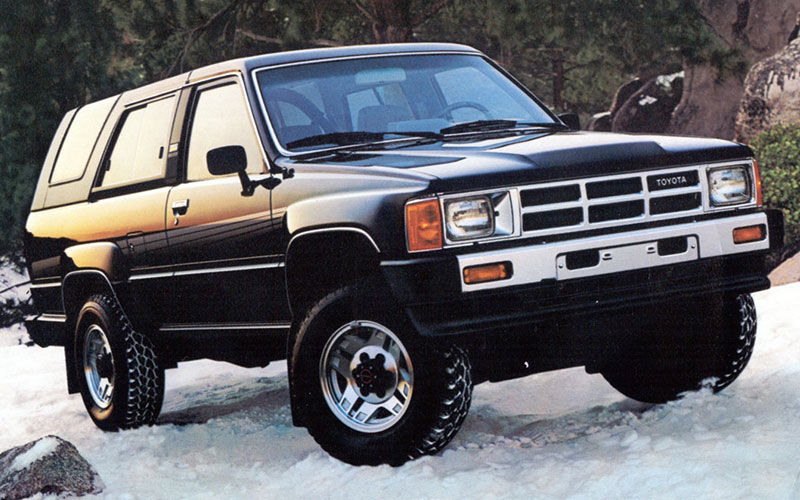
- Off-road racing was riding a peak in popularity in the early- to mid-1980s, having added stadium and short course races across the country alongside traditional desert racing. Terms from that exciting sport then entered the enthusiast’s vocabulary.
- A prerunner is an off-roader used by racers to scope out the course before a desert event. No doubt inspired by that term, Toyota named their new 4WD model the 4Runner (forerunner or 4WD runner, if you will).
- Introduced in 1984, the first generation 4Runner was based on the N30 Toyota Pickup, or Hilux, as it was known in most of the rest of the world.
- The 1984 4Runner had a shortened wheelbase and removable hardtop, mirroring many classic off-roaders.
- The first 4Runner was available only in 4WD with a solid front axle. It was powered by a 100 horsepower 2.4-liter four-cylinder 22R engine, which was mated to a five-speed manual transmission.
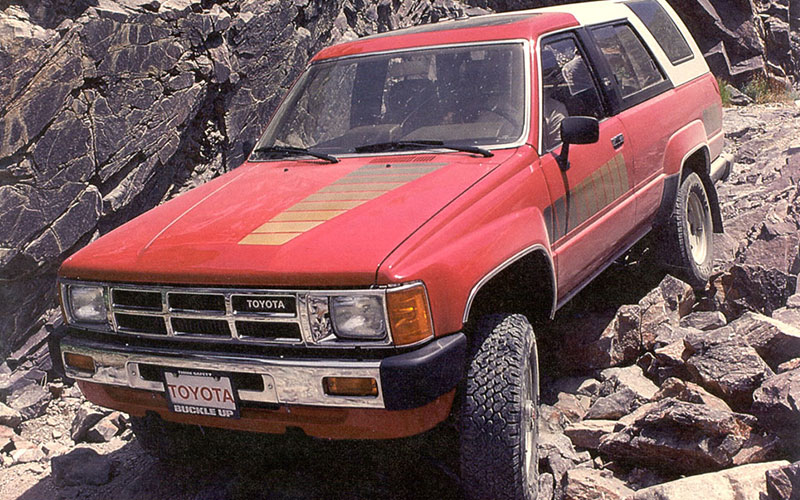
- An available SR5 trim package upgraded the interior with additional gauges, better fabrics, and a rear seat.
- The 1985 Toyota 4Runner received an upgraded 22R-E engine with electronic fuel injection. This upped the 4Runner to 116 horsepower.
- Toyota replaced the 4Runner’s solid front axle with independent front suspension for the 1986 model. This increased track width by three inches.
- A turbocharged version of the 22R engine was also introduced in 1986, too.
- For the 1988 Toyota 4Runner, an optional 3.0-liter 3VZ-E V6 engine replaced the turbo four-cylinder.
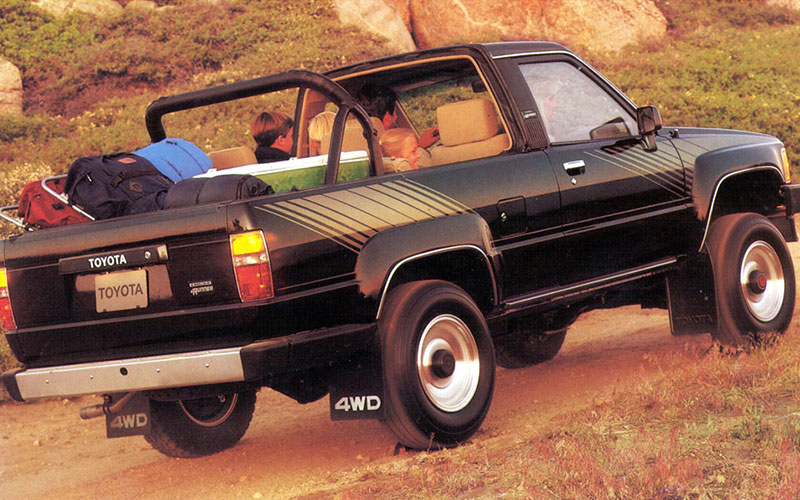
- Every first-generation 4Runner (and every model since, for that matter) was built by workers at the Tahara Assembly Plant in Tahara, Aichi, Japan.
Second Generation Toyota 4Runner (1990–1995)
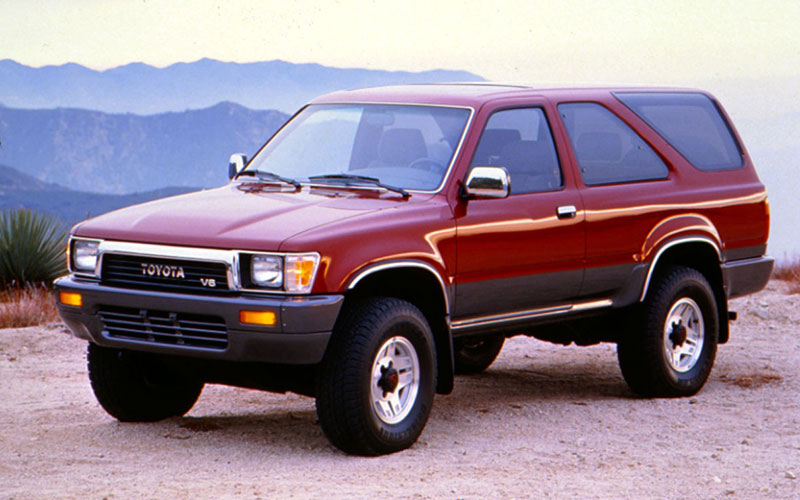
- While second-generation 4Runner models continued to be based on the Toyota pickup, the newer ones featured an integrated steel body mounted on the carried-over frame.
- Most second-generation 4Runners were sold as four-door models, but two-door versions were available during the 1990 and 1991 model years. They were dropped after that.
- Initial second-generation Improvements included optional shift-on-the-move 4WD, an upgraded interior, increased cargo space, and a new coil spring rear suspension system that replaced the old-school leaf spring setup.
- Turning somewhat from its off-roading-inspired origins, the second generation 4Runner was available only in a RWD configuration.
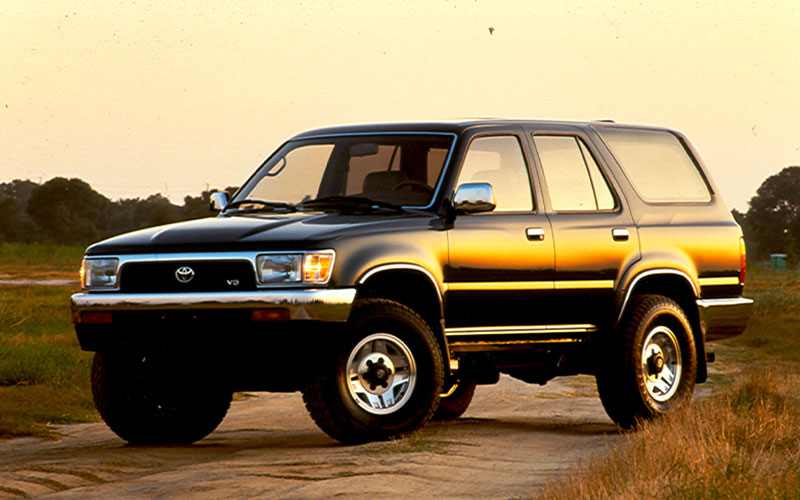
- For the first time, leather seating was an option in the 1992 4Runner. Power steering was also made standard on all trim levels.
- The RWD version of 4Runner was dropped for the 1993 model year due to low customer demand.
- More available creature comforts were added to the 1994 Toyota 4Runner, including an eight-speaker CD audio system, anti-lock brakes, and a sunroof.
- With Americans shifting their buying preferences from family minivans to family SUVs, Toyota responded with the Limited trim for the 1995 4Runner. It featured wood trim and leather seating.
Third Generation Toyota 4Runner (1996–2002)
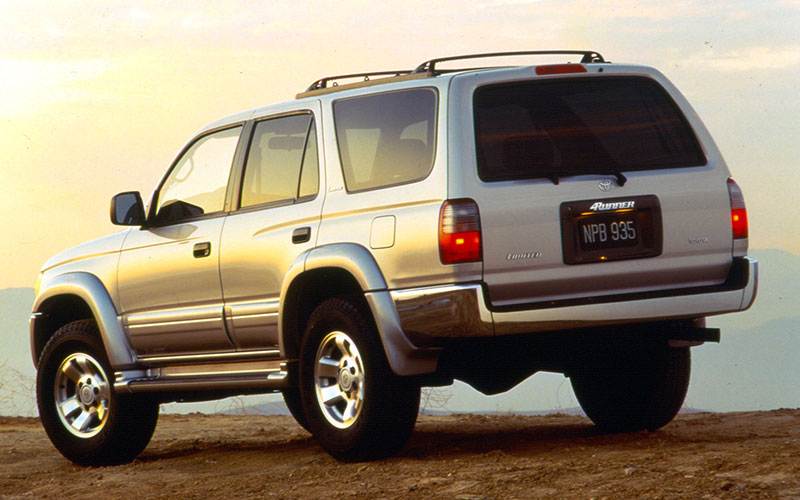
- For the first time, Toyota set the third generation 4Runner on its own chassis. The 1996 Toyota 4Runner no longer shared the same body as the Tacoma pickup truck (though much of the running gear was the same).
- The 1996 4Runner was a completely redesigned model with a greater emphasis on suburban utility and meeting higher safety standards.
- Riding on a longer wheelbase, the new body structure provided more interior passenger room and more generous cargo space.
- Toyota brought back the RWD configuration for the 1996 4Runner, which lowered the price and improved fuel economy.
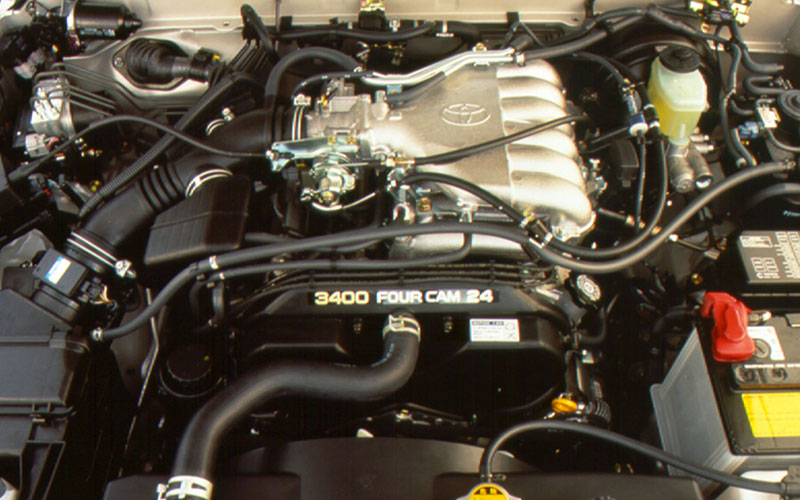
- A new base 2.7-liter 3RZ four-cylinder engine replaced the long-in-the-tooth 22R unit, while a new 3.4-liter 5VZ V6 replaced the outgoing 3VZ, adding 38 and 33 horsepower, respectively. The 2.7-liter totaled 150 horsepower with 177 lb.-ft. of torque, and the 3.4-liter made 183 horsepower with 217 lb.-ft. of torque.
- The 1997 Toyota 4Runner added the 2WD Limited trim to its lineup. The SR5 trim received minor cabin updates in the form of new fabrics.
- By 1999, the Toyota 4Runner was featured in the backdrop on dozens of TV shows like Baywatch, Seinfeld, NYPD Blue, the X-Files, Friends, ER. Those with a keen eye may have noticed it in movies like Kindergarten Cop, Highlander, and Men in Black.
- The combination of a cassette tape, CD player, and AM/FM radio was added as standard on 2000 Toyota 4Runner SR5 and Limited trims.
- Toyota added to the safety of the 4Runner with Vehicle Skid Control, Electronic Brake Force Distribution, and A-TRAC (Active Traction Control) for the 2001 model.
- 2001 Toyota 4Runners were available in three trim levels: the SR-5 (which was now the base), a middle-level Sport, and the premium Limited Edition.
- The 2002 Toyota 4Runner was the last model in the third generation of the popular SUV. It didn’t receive major updates. The 2002 4Runner base model was selling for $26,335.
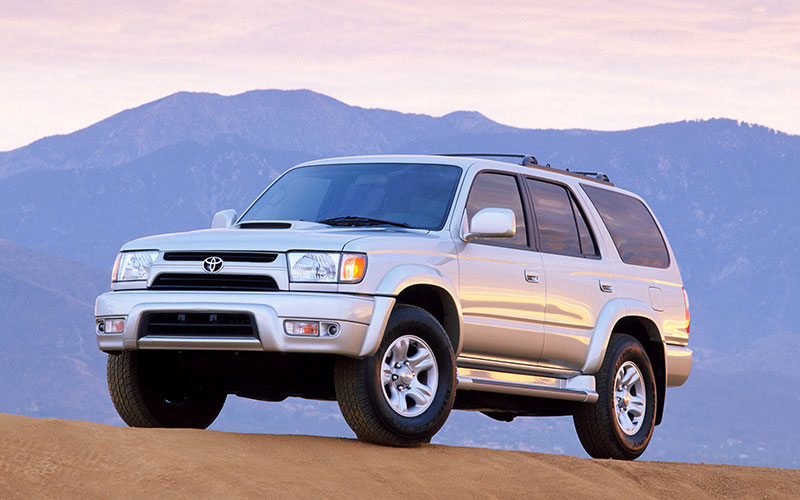
Fourth Generation Toyota 4Runner (2003–2009)
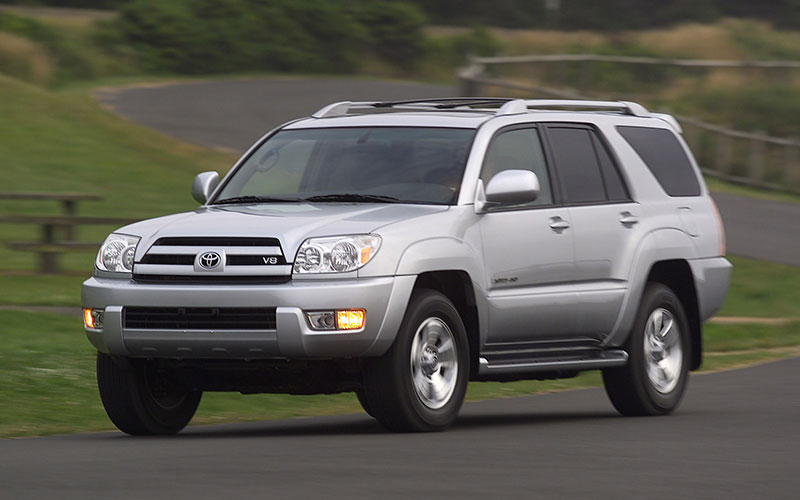
- The fourth-generation 2003 4Runner was moved onto the Toyota J120 platform, sold in many global markets as the Land Cruiser Prado and in the US as the Lexus GX 470.
- Though smoother and more car-like in exterior design than previous 4Runners, the fourth-generation model continued to offer greater off-road capabilities than many competitors, several of which had moved to car-based platforms.
- The 2003 4Runner retained a full ladder frame construction with a separate body shell.
- To further confirm its off-road credentials, all 2000 4runners were equipped with skid plates for the engine, transfer case, and fuel tank.
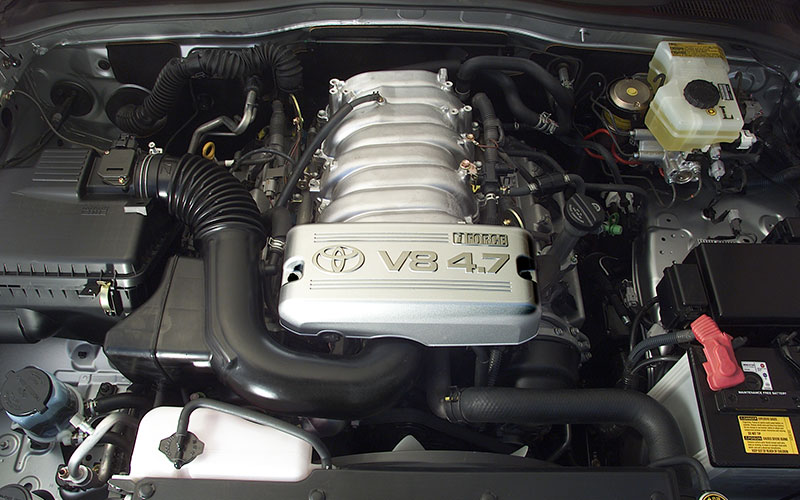
- There were two optional 4WD systems: a full-time AWD system on V8 models and a part-time system on V6 models, both utilizing a lockable Torsen center differential.
- The new Sport Edition was equipped with larger front brakes and a system called X-REAS (X-Relative Absorber System) designed to reduce body lean during hard cornering.
- Power was produced by an all-new 4.0 L GR-FE V6 that made 245 horsepower and 282 lb.-ft. of torque.
- A 235-horsepower 4.7-liter 2UZ-FE V8 engine was optional for the first time in the 2004 Toyota 4Runner.
- The combination of increased power and its stout ladder frame construction earned the fourth-generation 4Runner tow ratings of up to 7,200 lbs in the 2004 model.
- In a first for the 4Runner, an optional third-row seat was available. On SR5 and Limited models.
- For the 2005 model year, the addition of VVT-i (variable valve timing) increased output to 270 horsepower and 330 lb.-ft. of torque. The V6 was coupled to a four-speed automatic while the V8 was upgraded to a new five-speed automatic transmission in this model, too.
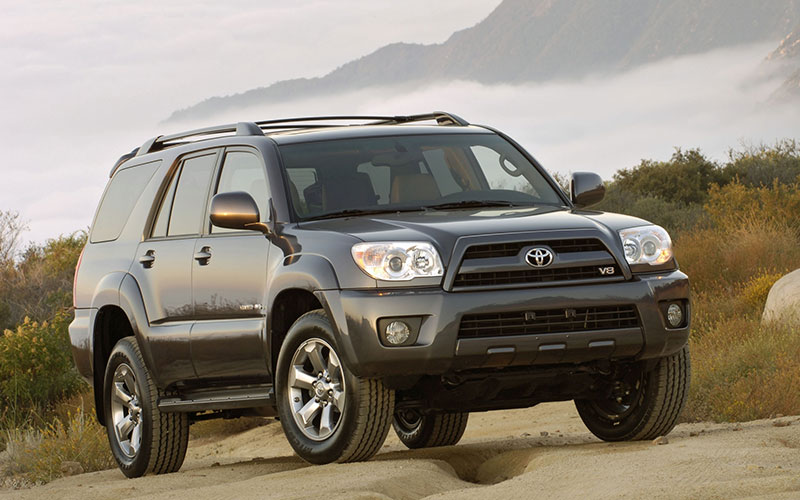
- Headlamps, bumpers, and the grille were all updated on the outside of the 2006 Toyota 4Runner.
- To close out the fourth generation, Toyota offered a Trail Edition package with the 2009 model year. The package includes an electronic locking rear differential, traction control, and Bilstein dampers.
Fifth Generation Toyota 4Runner (2010–2024)
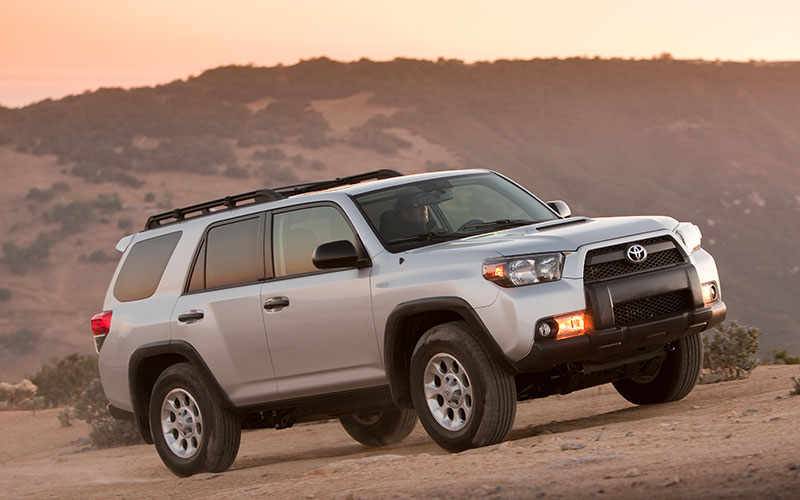
- Now, based on the J150 platform, which it again shares with the global Land Cruiser Prado and the Lexus GX series, the 2010 Toyota 4Runner made its debut in the heart of truck country: at the 2009 Texas State Fair.
- The 2010 4Runner was Initially available in three trim levels with the base SR5 trim and the top-of-the-line Limited trim available in 2WD or 4WD. The Trail Edition was only available in 4WD.
- The SR5 and Trail Edition 4WDs were fitted with a part-time 4WD drive system, while the Limited came equipped with full-time 4WD. The Trail Edition featured Toyota’s Kinetic Dynamic Suspension System (KDSS) and Crawl Control and a rear locking differential.
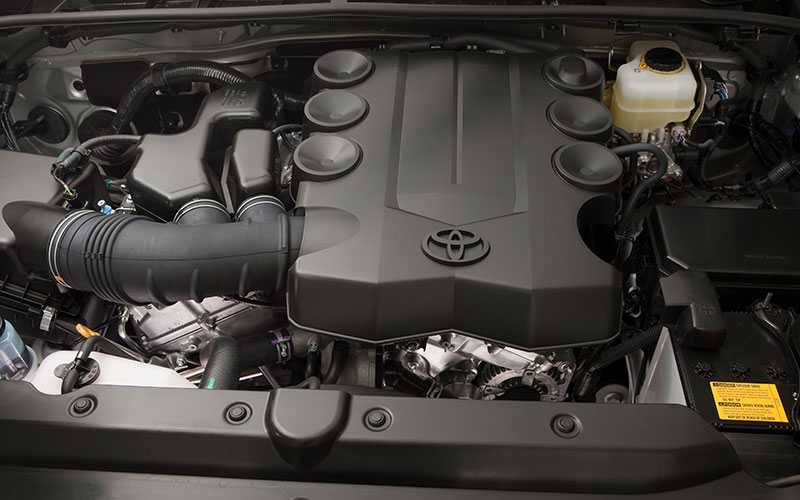
- Standard power came from a new 4.0-liter V6 engine with Dual VVTi that produced 270 horsepower and 278 lb.-ft. of torque. Optional was a budget-oriented 2.7-liter four-cylinder engine available in 2WD models, though it soon disappeared due to low customer demand.
- Toyota also dropped the 4.7-liter V8 engine from the 2011 4Runner lineup. Toyota stressed the increased power output and improved fuel economy of the V6, though it lost 2,000 lbs of towing capacity as a result.

- 2012 Toyota 4Runners still offered the optional third-row seat with a passenger capacity of seven people.
- New headlights and a little bit of new exterior styling were some of the minor updates for the 2014 Toyota 4Runner. Every 2014 model also came with a revamped cabin, which included a touchscreen audio system and smartphone integration.
- For the 2015 4Runner, Toyota introduced the new TRD Pro trim, which included Bilstein shocks with remote reservoirs, tuned front springs, and a front skid plate.
- Given the TRD label’s success in pulling in customers, Toyota renamed the 2016 4Runner Trail and Trail Premium the TRD Off-Road and TRD Off-Road Premium, though they do not share the same off-road suspension as the TRD Pro model.
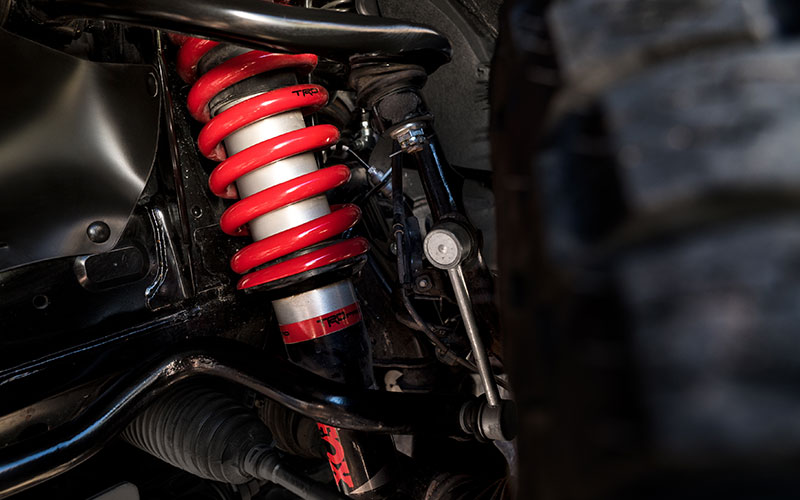
- Toyota set out to prove the capabilities of the 2017 4Runner TRD Pro at the Baja 1000. With only a change of tires, the 4Runner TRD Pro took on the same 1,130 route as the racers without so much as a hiccup.
- More than 139,600 of the 2018 4Runner were sold in the U.S., making it the most successful model year so far.
- The 2019 Toyota 4Runner TRD Pro was given new Fox shock absorbers, a new skid plate, and a new roof rack. A Limited Nightshade Edition was also made available with a black-out color scheme.
- A suite of Toyota Safety Sense technologies was added to the 4Runner for 2020 Toyota 4Runner.20 That suite included an eight-inch infotainment touchscreen with Bluetooth, Apple CarPlay, Android Auto, and Amazon Alexa integration.
- Also new for 2020 was the implementation of Toyota Safety Sense, which included a pre-collision system with pedestrian detection, lane departure alert with a sway warning system, automatic high beams, and dynamic radar cruise control.
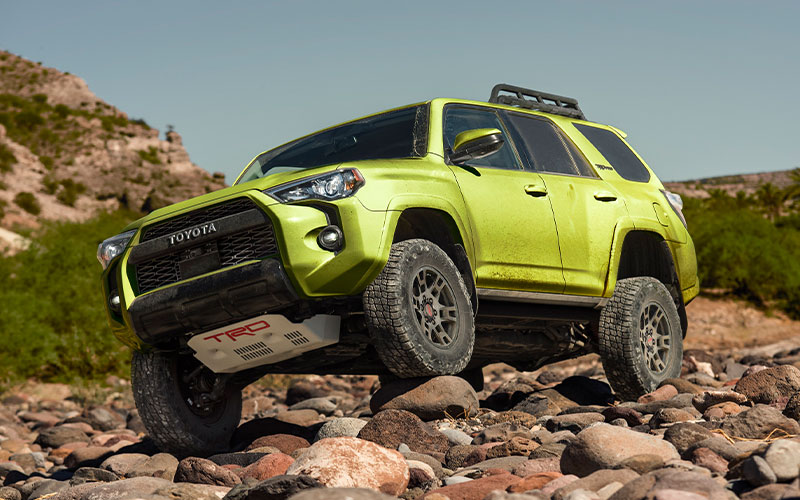
- The 2021 4Runner included a Trail Special Edition, several TRD Pro upgrades, and revised LED headlights across all trim levels. The Trail Special Edition featured extra storage with a Toyota-branded 40-quart cooler and a sliding cargo tray.
- Despite not being given a full redesign since 2010, nearly 144,700 of the 2021 4Runners were sold, making it the most successful model year to date.
- The most significant changes in 2021 models were to the TRD Pro trim. Most apparent was the 17-inch flow form wheels and Nitto Terra Grappler tires. Other upgrades include re-tuned 2.5-inch Fox bypass shocks and new front springs that raise the ride height by an inch.
- One more trim, the TRD Sport, was added to the 2022 Toyota 4Runner lineup. LED headlights became standard across the lineup.
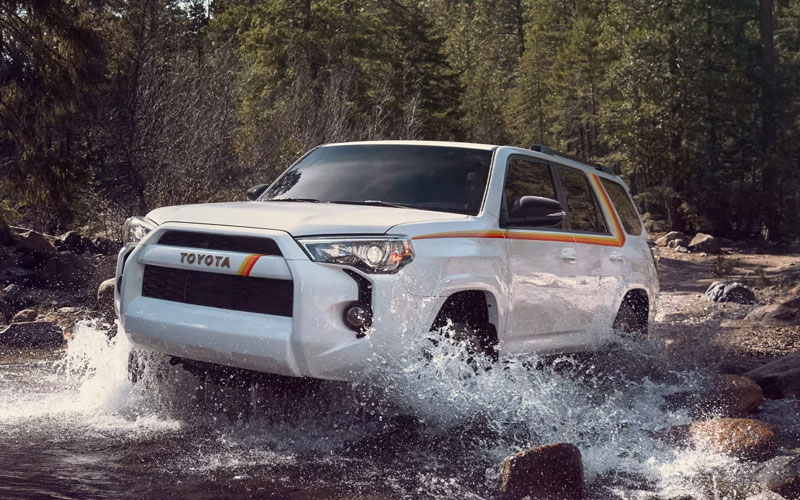
- Still part of the fifth generation, the 2023 4Runner started at $39,555. This model marked the 40th anniversary of the 4Runner. To celebrate, Toyota announced 4,040 available models of a special edition SR5 in red, white, or black paint.
- This special edition rode on a set of 17-inch wheels. Inside was bronze stitching on leatherette seats and the shift knob. Special badging was also placed on the headrests, floor mats, and other areas inside the cabin.
- Blind-spot monitoring and a rear cross-traffic alert, both new additions to the 4Runner, were standard on every 2023 model. You can read about every feature, including the specs, in our 2023 Toyota 4Runner review.
- You can see in our full 2024 Toyota 4Runner review that this model didn’t have any major updates. It was still part of the fifth generation that was introduced in 2010, but that was about to change.
Sixth Generation Toyota 4Runner (2025–Present)
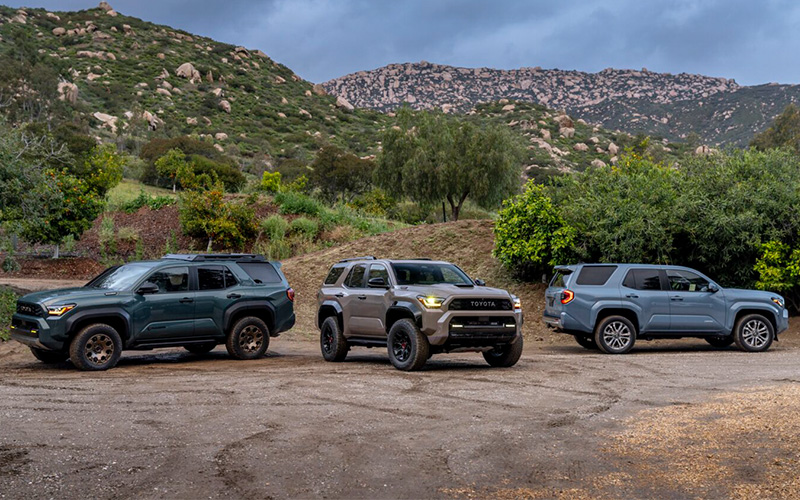
- The all-new 2025 Toyota 4Runner will be the start of the sixth generation of the famed SUV. On sale in the fall of 2024, the new 4Runner will have several new upgrades. Toyota is using its TNGA-F global truck platform for the 2025 4Runner. It’s the same steel-ladder frame used for the Tacoma, Tundra, Sequoia, and Land Cruiser.
- Under the hood is an i-FORCE MAX powertrain that utilizes a 2.4-liter four-cylinder turbo engine. It’s mated to an eight-speed automatic transmission to produce 278 horsepower and 317 lb.-ft. of torque. This combination can tow up to 6,000 lbs.
- There’s also a hybrid version that uses that turbo and adds a 48-horsepower electric motor. It’s integrated with the eight-speed automatic. With the 1.87-kWh battery pack, the hybrid system puts out up to 326 horsepower and 465 lb.-ft. of torque.
- Another change can be found in the drivetrain. This 4Runner will be offered as a 2WD, 4WD, and part-time 4WD vehicle. The 4WD models use an electronically controlled two-speed transfer case. The Multi-Terrain Select system functions in 4WD-High and 4WD-Low modes, too.
- In total, nine different trim levels are part of the 2025 lineup: the SR5, TRD Sport, TRD Sport Premium, TRD Off Road, TRD Off Road Premium, Limited, Platinum, TRD Pro, and Trailhunter.
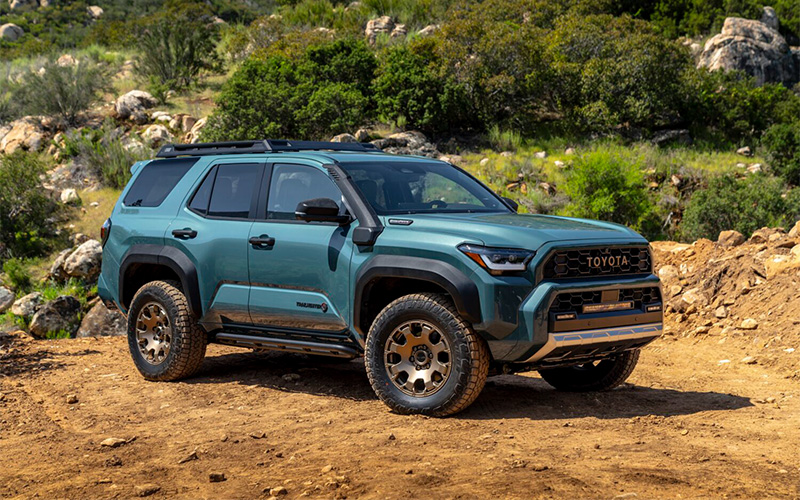
2025 Toyota 4Runner – pressroom.toyota.com | Shop Toyota 4Runner on Carsforsale.com
- While the initial touchscreen size remains eight inches, there’s another 14-inch version that’s available. The 2025 4Runner cabin also has an available Qi wireless charging pad.
- The safety suite was enhanced with pre-collision pedestrian detection, a lane departure alert with steering assist and the recognition of 3D objects, dynamic radar cruise control, and lance tracing assist, which helps provide more space between vehicles in passing situations.
- Production hasn’t started yet, but will take place at the Toyota plant in Tahara, Japan. From there, the 2025 4Runners will be shipped to the U.S. and be on sale by the end of 2024. In the meantime, we have even more published 4Runner content to look at, such as our Budget Buy: Toyota 4Runner vs Ford Explorer comparison.



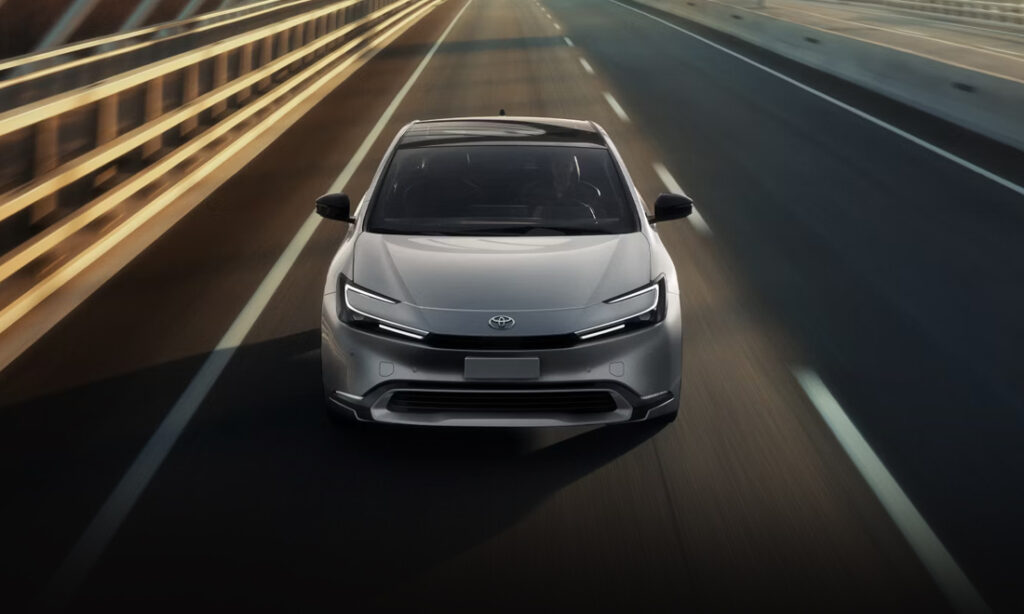

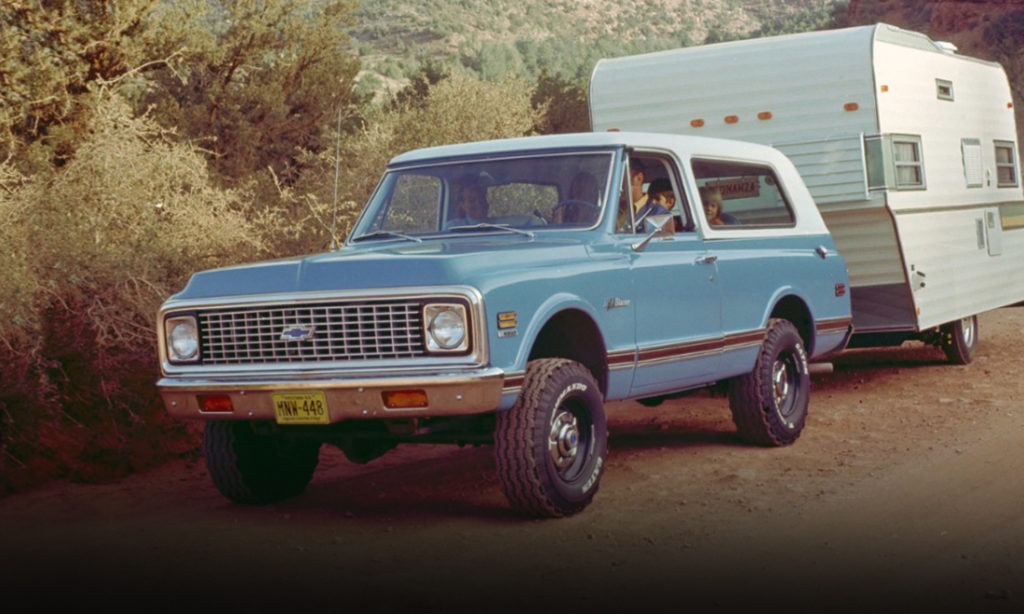
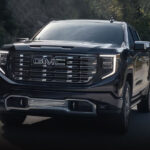



The 2003-2009 was the nicest the current ugliest !
This is the best 4Runner article I’ve read in a very long time. Most of the current ones you read are written by someone who seems to wish every SUV in existence was a bubble SUV only made for the daily commute. They never seem to get it. 4Runners are obviously not for them. Once again, well done.
Thanks Rick!